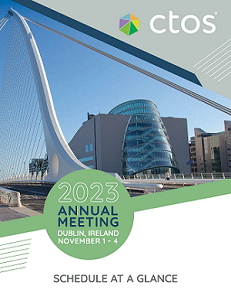Novel Diagnostics and Bioinfomatics
(P 223) SIGNATERA CTDNA TRACKER IN SARCOMA: CLINICAL EXPERIENCE
Location: The Liffey, Level 1

Adrienne Victor, MD (they/them/theirs)
Assistant Professor
University of Rochester
Rochester, New York, United States
Author(s)
Objective: Circulating tumor DNA (ctDNA) holds promise as a biomarker for disease burden and risk profiling in all cancers, and may be particularly valuable in sarcomas which lack circulating tumor markers. Use of ctDNA as a clinical tool has been limited, with most data confined to a research-use-only setting. He we report our institutional experience with the signatera assay, a commercial test tracking 16 tumor-specific, clonal, somatic, single nucleotide variants (SNVs) and reported as a number of mean tumor molecules per milliliter (MTM/ml).
Methods: Signatera results on all sarcoma patients at the University of Rochester were reviewed and compared with clinical outcomes.
Results: Thirty-two patients with sarcoma had signatera testing completed. Six tests failed, usually due to insufficient remaining tissue for sequencing. Twenty-six had results, of which 13 were positive and 13 negative. The average time from having all materials (plasma drawn + tumor received for sequencing) to first result was 19 days (range 11-37). The average time from the second draw to result was 8 days (range 5-18). For those with metastatic disease at time of testing, 10 were positive and 4 were negative. For those without known metastatic disease, 3 were positive and 8 were negative. One patient had an initial very low positive test (0.04 MTM/ml) after finishing curative intent treatment that was subsequently negative without additional intervention. Three patients with measurable disease (all metastatic) were ctDNA negative vs 11 with measurable disease (8 metastatic) had detectable ctDNA.
Conclusion: Signatera was positive in 79% (11/14) of sarcoma patients with clinically detectable disease and 17% (2/12) of patients who were no evidence of disease (NED) at evaluation prior to testing. One of these appeared to be a “false positive” while the other is pending restaging scans. This test may be particularly valuable when imaging is indeterminant. The lead time to first result may make it difficult to utilize this test in risk stratifying for neoadjuvant therapy, but could be feasible in the adjuvant setting. Criteria for response, progression, and optimal frequency of testing requires further study. The need for tissue and sequencing solely for the signatera assay is a potential limitation.
Methods: Signatera results on all sarcoma patients at the University of Rochester were reviewed and compared with clinical outcomes.
Results: Thirty-two patients with sarcoma had signatera testing completed. Six tests failed, usually due to insufficient remaining tissue for sequencing. Twenty-six had results, of which 13 were positive and 13 negative. The average time from having all materials (plasma drawn + tumor received for sequencing) to first result was 19 days (range 11-37). The average time from the second draw to result was 8 days (range 5-18). For those with metastatic disease at time of testing, 10 were positive and 4 were negative. For those without known metastatic disease, 3 were positive and 8 were negative. One patient had an initial very low positive test (0.04 MTM/ml) after finishing curative intent treatment that was subsequently negative without additional intervention. Three patients with measurable disease (all metastatic) were ctDNA negative vs 11 with measurable disease (8 metastatic) had detectable ctDNA.
Conclusion: Signatera was positive in 79% (11/14) of sarcoma patients with clinically detectable disease and 17% (2/12) of patients who were no evidence of disease (NED) at evaluation prior to testing. One of these appeared to be a “false positive” while the other is pending restaging scans. This test may be particularly valuable when imaging is indeterminant. The lead time to first result may make it difficult to utilize this test in risk stratifying for neoadjuvant therapy, but could be feasible in the adjuvant setting. Criteria for response, progression, and optimal frequency of testing requires further study. The need for tissue and sequencing solely for the signatera assay is a potential limitation.

